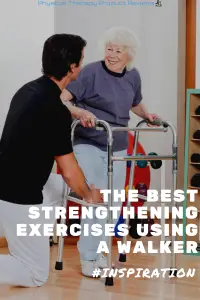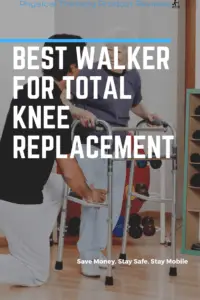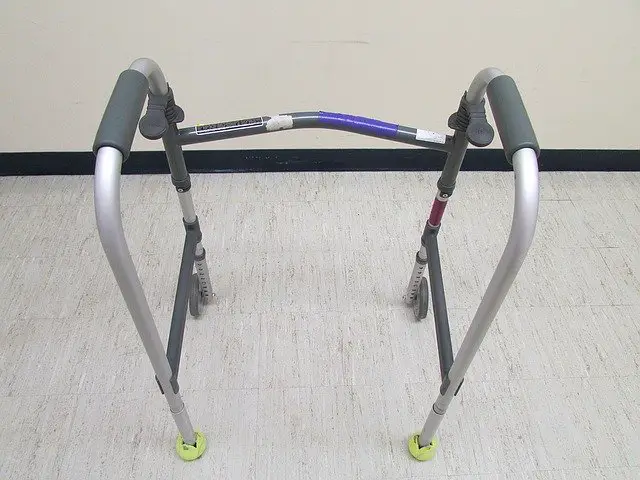Strengthening Exercises While Using a Walker
 It has been reported that about 17% of people age 65 and overuse a walker of some sort (CDC). Whether it be used to increase balance or to increase confidence getting around, walkers are commonly used by older adults.
It has been reported that about 17% of people age 65 and overuse a walker of some sort (CDC). Whether it be used to increase balance or to increase confidence getting around, walkers are commonly used by older adults.
While a walker is meant to help with balance it doesn’t mean users are not vulnerable to falls. Data has shown that 129 seniors are treated in emergency rooms each day for injuries caused by falls using a walker or cane. One reason for this is because older adults using walkers were a fall risk before the assistive device. So it becomes even more important for those using walkers to perform an exercise to improve their strength, balance, and stability.
Listed below are five exercises with a walker that can easily be done at home with. If your walker has brakes, make sure they are engaged. If you’re concerned your walker will roll forward, position it against the wall or couch to keep it from moving. You can also stand in front of a couch or chair in case you get tired or lose your balance.
Why Exercise with a Walker?
A walker is an excellent tool to help with exercise, especially in the elderly and frail population. If you don’t have a walker already they are actually incredibly affordable online, see our reviews of the best walkers here.
- Walkers are affordable
- Reduce the risk of fall and serious injury
- They are easy to transport
- Usually nearby for on the spot exercise
Do you need a walker but are concerned about how much it might cost? Check out our reviews of the best walkers online for an affordable price. 
Standing March with a Walker
While standing with your hands on your walker, raise up one knee allowing it to bend as you raise it. Keep your back straight, try not to hunch over. Hold this position for 5 seconds. Put the leg back down and continue for 10 repetitions. Once done repeat on the opposite side. This exercise will help improve your hip flexor strength on one side of the body and improve the single-leg balance on the other leg, its a win-win!
Standing Hip Abduction
Standing at your walker, standing up straight with your feet hip-width apart, start to raise your leg straight out to the side. Keep your knee straight, and try to keep your toes pointing forward. Repeat 10 times and then move onto the other side repeating the same sequence. Do as many as you can and expect to feel this in the upper part of both hips. If this is too easy you can add a resistance band to build up muscle faster.
Standing Hip Extension
Starting in the same position as the previous exercise, start to raise your leg straight backward. With this exercise resist the temptation to lean forward as you bring your leg back. Try to stay upright through your back to get the full benefit. Perform 10 times on one leg, and then repeat on the opposite leg. This exercise should feel like the back of the hip is working hard. Again, this exercise can be made more difficult using a resistance band.
Mini Squat Exercise With a Walker
Standing with your feet hip-width apart, start to bend your knees like you are going to sit back into a chair. Make sure that you are shifting your weight back to your heels and that your knees are not going over your toes. Slowly come fully back up to stand and do 10 more. Be sure to keep your hands on the walker at all times for balance. This is one of the best ways to strengthen and exercises with a walker. It is also one of the quickest exercises to improve total body strength.
Heel Raise Exercises With a Walker
Standing with your walker, slowly start to raise both heels off the ground coming onto your toes. Then slowly, with control, bring your heels back down to the ground. You should feel this exercise in your calves with the movement. Repeat this exercise 10 times. You cannot do too many of these are an excellent exercise to try and “do 20” every time you stand up. These are endurance muscles and need to be worked often.
Don’t worry if you can’t do these exercises perfectly or if you can’t do all of the repetitions. The more you practice, the more strength and balance you will gain, and be able to do more. You may even start to notice some improvements in your balance and strength with other daily activities you do.
Written By: Kelsey Downing, DPT
Kelsey Downing earned her Doctor of Physical Therapy (DPT) degree in 2016 from Campbell University in Buies Creek, NC. Since then, she has been working in a variety of settings. From outpatient, acute care, and home health she has gained a wealth of hands-on knowledge. Additionally, she has sought out further certification in manual therapy, concussion management, and lymphedema management. She continues to be driven to learn and refine her skills to improve patient care.
Works Referenced:
“Press Release.” Centers for Disease Control and Prevention, Centers for Disease Control and Prevention, www.cdc.gov/media/pressrel/2009/r090629.htm.
Stevens, Judy A., et al. “Unintentional Fall Injuries Associated with Walkers and Canes in Older Adults Treated in U.S. Emergency Departments.” Journal of the American Geriatrics Society, vol. 57, no. 8, 2009, pp. 1464–1469., doi:10.1111/j.1532-5415.2009.02365.x.
Disclaimer: The information provided in this post is for educational purposes only. This is not a substitute for a medical appointment. Please refer to your physician before starting any exercise program.


